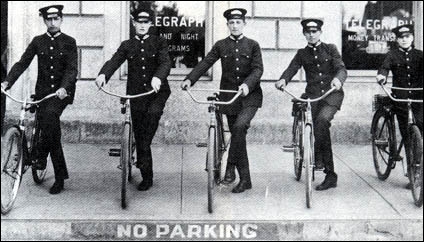Vol. 18 No. 5
May, 1988
|
Make Tomorrow Happen
|

Life & Times
of
Telegraph
Messengers
|

Omer Lavallee
Corporate Historian
Emeritus
|

A group of uniformed messengers at
Moose Jaw around 1925. Second from left is Henry Kerr who passed away in 1971. He worked for CP Telecommunications
for 47 years.
This month we're going to deal with commercial telegraphs, once an
important adjunct of CPR operations. The topic was suggested by Doug Macleod, retired general manager of
telecommunications, who sent me the accompanying photograph.
The many and diversified electronic-age services now offered by this branch of transportation - that of
information - now enjoys an incomparably-higher profile in business than in the
not-too-distant past.
Then, when the traffic was made up exclusively of business and personal messages and money transfers, the most
visible public symbol of "wire" communications, apart from the signs on the offices themselves, was the
telegraph messenger, a young man clad in a rather elaborate uniform and riding on a bicycle. He was the symbol
despite the fact that he was far outnumbered by all of the other personnel behind the scenes, engineers, commercial
representatives, telegraphers, teletype operators, and delivery clerks, to name only a few.
In the United States, the telegraph messenger was popularly known as a "Mercury" after the
messenger-god of classical mythology. Not to ignore the distaff side, it must be said that during and
after the last war, many girls were recruited to messenger staffs, lending an element of charm to the force, which
in large cities might number several hundred girls and boys.
Often Bearers of Bad News
For private households, the messenger not infrequently was the bearer of bad news, such as the deaths of relatives
or close friends. As a child, I remember my devoted, Irish-origin maternal grandmother becoming very
upset merely at the appearance of a telegraph messenger at the door.
"Oh Bertha, the saints preserve us all", she would say, "there's a telegraph boy at the door. I hope
that cousin Ann hasn't..." leaving the thought unsaid. She would have her spinster daughter open the door, sign
for the telegram, then read it to her.
Fortunately, her fears were usually unfounded as telegrams to her home rarely contained evil tidings. Most were on
more mundane matters usually connected with my grandfather's custom upholstery business. Still, the sense of
foreboding was always there.
Although most messengers were in their teens, there was always a small core of adults in the major cities who rode
to their destinations on streetcars and busses rather than on bicycles. To these were entrusted important messages,
including advice of family deaths.
One such retired person related to me that it was the practice, when a telegram carried news of someone's death, to
go first to a neighboring home to find out if the addressee was alone, elderly, or infirm, and when necessary, ask
the neighbor to accompany the messenger to the door when the telegram was delivered. Of course, there was no need
for this precaution if the message announced a new member of the family, anniversary congratulations, or, more
rarely, an inheritance.
Delivery of Written Messages Essential
Physical delivery of messages in written form was essential prior to the Second World War, when few private
households were affluent enough to have telephones. Moreover, business customers preferred to have communications
delivered to them in written form and by hand. Since the telegraph company routinely filed the original messages
written or typed by the sender, a telegram normally enjoyed the legal status of a signed letter.
The basic personnel - agents, telegraphers, typists, and messengers - were usually provided with their own
"store-front" offices in the downtown areas of medium and large-sized centres.
The railway station and its personnel fulfilled these functions in small localities. In large communities, such
offices were often adjuncts of railway and steamship ticket and travel bureaus.
In the major cities, there were literally dozens of neighborhood telegraph offices to make the use of this service
convenient to as many potential customers as possible. Usually, within a few metres of a Canadian Pacific office -
and sometimes right next door - a similar office of "the competition", when Canadian National Telegraphs,
could be found.
We'll look at some telecommunications history in the next issue.
This CP Rail News article is copyright
1988 by the Canadian Pacific Railway and is reprinted here with
their permission. All photographs, logos, and trademarks are the property of the Canadian Pacific Railway
Company.
|